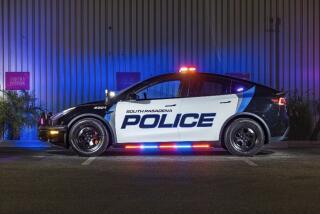Pedal Patrol
- Share via
Lesson one heard by the attentive cops and other security personnel this week in the Glendale Police Department’s briefing room: Just say no to fries, chocolate shakes and “double-doubles.”
Instead, agent Darrell York told the 25 men and women in the department’s Bicycle Patrol Training School, eat a big bowl of pasta and drink plenty of water prior to an eight-hour shift on two wheels.
The nutrition lesson was one of the first in the three-day course meant to train some Southern California police officers, security officers and paramedics in how to perform their duties on a bicycle.
“We can get in and out of buildings and alleys,” said Officer David Buckley, citing one advantage of arriving at a crime scene on a bike rather than in a patrol car. “We can catch possible drug dealings or thefts in progress.”
This week’s class is the third the Glendale department has put on, according to Sgt. James Fitzgerald, the assistant coordinator for the department’s bicycle unit.
The students at the course, being taught by officers from Glendale and the Burbank Police Department, come from those two departments as well as the L.A. Port Police, security personnel from the Glendale Galleria and paramedics from Med-Trans.
“Public relations is one of the advantages” of bike policing, said Fitzgerald. “We don’t seem to intimidate when we’re on a bicycle.”
With its courses, Glendale’s police are tapping into a law enforcement wave of the future, Fitzgerald said.
Seattle pioneered bike-riding officers, and other departments, including the Los Angeles Police Department, have followed. The LAPD certifies officers on bike patrol in each division, with the largest stationed in the Pacific Division to patrol Venice Beach.
One of those advantages is financial, said Fitzgerald.
A fully equipped patrol car costs about $25,000; a bike about $1,000.
Glendale already has 50 officers trained, Fitzgerald said. The department’s goal is to certify all of the city’s 250 police officers to patrol on bikes when needed.
This week’s training does not include actual police work techniques; the officers have long gone through academy training, and the security officers and paramedics also have had their formal training.
What the course will teach them is proper nutrition, bike-riding tactics--including how to ride down flights of stairs while chasing a suspect and 15-mile endurance rides at Griffith Park and the Burbank foothills--and the importance of public relations.
“When was the last time someone walked up to the paramedics just to talk?” said David Givot, a Glendale Med-Trans paramedic in the class who already has had some experience working from two wheels. “When you’re on a bike they want to talk about hockey scores in a positive, totally stress-free way.”
The bikes aren’t bad as crime-fighting tools, either, some officers said. They allow the officers to go through crowds more quickly and pursue criminals in paths where cars can’t follow.
Fitzgerald said though officers who work on bikes can’t cover large areas, they still have an arrest rate four to five times higher than their car patrol counterparts because they are able to cover their beat in more detail.
Said officer Keith Soboleski, who works in Glendale’s anti-gang unit: “The stealth part comes into it. You can go in the park and sneak up on [potential criminals].”
More to Read
Sign up for Essential California
The most important California stories and recommendations in your inbox every morning.
You may occasionally receive promotional content from the Los Angeles Times.













